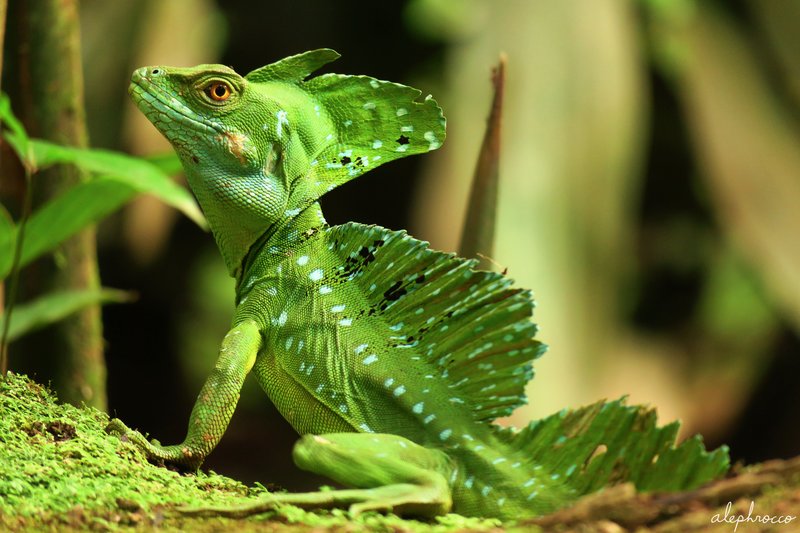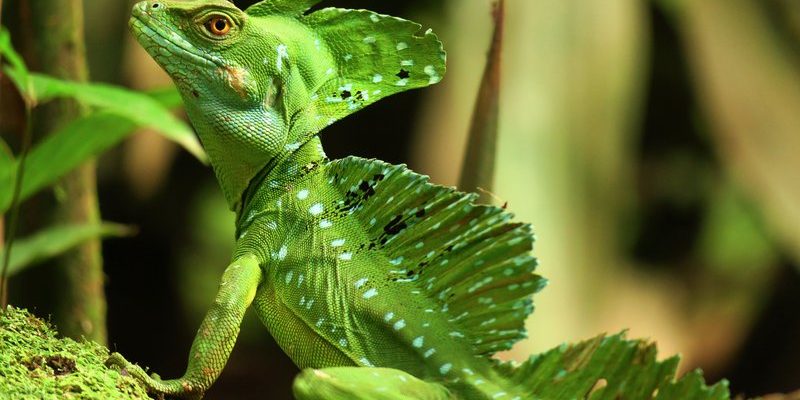
To put it simply, the basilisk lizard isn’t a threat to us. They’re more like nature’s quirky little performers, showcasing their unique skills. That said, understanding the basilisk’s behavior and habitat can help clear up any concerns and paint a clearer picture of how these creatures interact with humans.
What is the Basilisk Lizard?
The basilisk lizard, often called the “Jesus Christ lizard” due to its remarkable water-running ability, belongs to the *Ctenosaura* genus. These lizards are native to Central and South America, specifically found in rainforests, near rivers, and along the edges of water bodies. Basilisks can grow up to 2.5 feet long, including their long tail, which aids in balance and agility.
These reptiles have a striking appearance, with vibrant green or brown skin, depending on the species. They also boast a spiky crest along their back. If you looked closely, you’d see their large, expressive eyes, which help them spot predators from a distance.
Are Basilisk Lizards Aggressive?
Here’s the thing: basilisk lizards aren’t born warriors. They prefer to avoid confrontation. When threatened, their first instinct is to flee, not fight. This means they’re more likely to dash away than to engage with humans or other animals. However, if they feel cornered or directly threatened, they may display aggressive behavior, including hissing or puffing up their bodies.
In general, basilisk lizards are shy and non-aggressive. They’re not out looking for trouble. Instead, they focus on their daily lizard lives, characterized by basking in the sun and foraging for insects, fruits, and flowers.
Can Basilisk Lizards Bite?
Although basilisk lizards won’t come looking for trouble, they can, indeed, bite if they feel threatened. Luckily, their bite isn’t dangerous to humans. It’s more like a reminder that they want space. If you’re ever in close proximity to one and it bites you, it might sting a bit, but you won’t face any serious health risks.
That said, the bite of a basilisk lizard may still lead to minor injuries, like a scratch or puncture wound. It’s essential to wash the area promptly and keep an eye out for any signs of infection. But honestly, if you respect their space and observe them from a distance, you’re likely to avoid any bite scenarios altogether.
How to Safely Observe Basilisk Lizards
If you find yourself in an area where basilisk lizards roam, how can you enjoy watching them without risking your safety? Here are some tips:
- Keep Your Distance: Respect their space. Observing them from a few feet away ensures they feel safe.
- Avoid Sudden Movements: Quick movements can scare them off. Instead, move slowly and calmly.
- Use Binoculars: This handy tool allows you to see their incredible features without getting too close.
- Don’t Feed Them: Feeding wildlife can encourage them to approach humans, which isn’t safe for either party.
Observing these lizards can be a delightful experience, as long as you’re mindful of their needs and behaviors.
Are There Other Dangerous Lizards? Comparing Threat Levels
While basilisk lizards are generally harmless, not all lizards are the same. Here’s how they stack up against some other lizard species:
- Komodo Dragon: This giant lizard can pose a threat due to its size and venomous bite.
- Iguanas: Though mostly harmless, they can bite in self-defense and have strong jaws.
- Monitor Lizards: Some species, if provoked, can also bite and inflict serious injuries.
Compared to these lizards, basilisk lizards are quite safe to be around. Their defensive strategies revolve around escape and evasion, making them much less threatening.
Basilisk Lizards in Pop Culture
You might be surprised to learn that basilisk lizards have made their way into pop culture! They’re often referenced in movies, books, and even video games. Their unique running ability has inspired artists and storytellers alike.
For example, in the Harry Potter series, the *basilisk* is a giant snake that symbolizes danger. While it’s entirely different from our friendly *basilisk lizard,* it highlights how imaginative interpretations can diverge from reality. It’s an interesting juxtaposition that makes us appreciate the actual lizards even more.
So, can the basilisk lizard be dangerous to humans? The answer is, not really. These amazing creatures might be a bit quirky and can bite if scared, but they’re not out to harm us. Instead, they’re fascinating examples of adaptation and resilience in nature.
The next time you find yourself near their habitat, take a moment to appreciate their unique talents—like running on water! Remember, respecting their space is crucial. By doing so, you’ll not only enjoy observing these incredible lizards but also help ensure their well-being in the wild.

